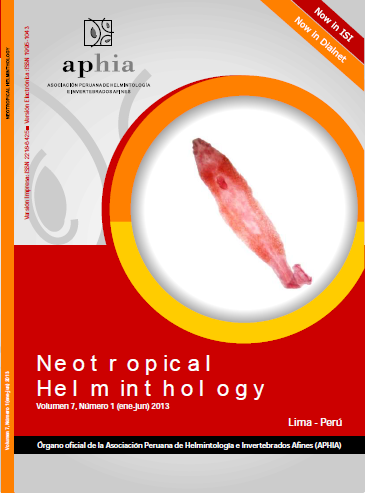MIGRATION ROUTES OF TOXOCARA CANIS AND TOXOCARA CATI IN TISSUES OF EXPERIMENTALLY INFECTED RATTUS NORVEGICUS
DOI:
https://doi.org/10.24039/rnh201371957Keywords:
larval recovery, migration routes, Rattus norvegicus, Toxocara canis, Toxocara cati.Abstract
Toxocariasis is currently considered an important zoonosis in many countries and is usually attributed to larvae of Toxocara canis Werner, 1782 but less frequently, T. cat. This study attempts to compare the migration routes followed by T. canis and Toxocara cati (Schrank, 1788) in Rattus norvegicus Berkenhout, 1769 and to determine the percentage of larvae recovered in each organ of experimentally infected rats. Twenty-one 8-week-old, male specimens of R. norvegicus (Wistar) were inoculated orally with 500 embryonated eggs of T. canis, while another 21 rats of the same species were inoculated orally with 300 embryonated eggs of T. cati. On postinfection days 3, 5, 8, 10, 15, 30 and 60, three rats from each group were sacrificed and larval recovery was performed from various organs and the carcass following digestion with 0.5% HCl method. Comparisons of the percentage of recovered larvae revealed that T. cati larvae migrated in greater quantities, as early as day 3 postinfection, to the lungs (23.77%, compared to 0.34% for T. canis), while migration of T. cati larvae to the carcass was observed from day 3 up to day 60 postinoculation. This experiment verified that the larvae of these two species follow distinct migration routes and have different recovery rates.
Downloads
Published
How to Cite
Issue
Section
License
Copyright (c) 2021 Neotropical Helminthology

This work is licensed under a Creative Commons Attribution-NonCommercial-NoDerivatives 4.0 International License.
OBJETO: El AUTOR-CEDENTE transfiere de manera TOTAL Y SIN LIMITACIÓN alguna al CESIONARIO los derechos patrimoniales que le corresponden sobre la (s) obra(s) tituladas: xxxxxxxxxxxxxxxx, por el tiempo que establezca la ley internacional. En virtud de lo anterior, se entiende que el CESIONARIO adquiere el derecho de reproducción en todas sus modalidades, incluso para inclusión audiovisual; el derecho de transformación o adaptación, comunicación pública, traducción, distribución y, en general, cualquier tipo de explotación que de las obras se pueda realizar por cualquier medio conocido o por conocer en el territorio nacional o internacional.
REMUNERACIÓN: La cesión de los derechos patrimoniales de autor que mediante este contrato se hace será a título gratuito.
CONDICIONES Y LEGITIMIDAD DE LOS DERECHOS: El AUTOR-CEDENTE garantiza que es propietario integral de los derechos de explotación de la(s) obra(s) y en consecuencia garantiza que puede contratar y transferir los derechos aquí cedidos sin ningún tipo de limitación por no tener ningún tipo de gravamen, limitación o disposición. En todo caso, responderá por cualquier reclamo que en materia de derecho de autor se pueda presentar, exonerando de cualquier responsabilidad al CESIONARIO.
LICENCIA DE ACCESO ABIERTO: El AUTOR-CEDENTE autoriza que manuscrito publicado en La Revista Neotropical Helminthology permanece disponible para su consulta pública en el sitio web https://www.neotropicalhelminthology.com/ y en los diferentes sistemas de indexación y bases de datos en las que la revista tiene visibilidad, bajo la licencia Creative Commons, en la modalidad Reconocimiento-No comercial- Sin Trabajos derivados –aprobada en Perú, y por lo tanto son de acceso abierto. De ahí que los autores dan, sin derecho a retribución económica, a la Asociación Peruana de Helmintología e Invertebrados Afines (APHIA), los derechos de autor para la edición y reproducción a través de diferentes medios de difusión.


 Numero 2 Volumen 19 - 2025 (versión Anticipada)
Numero 2 Volumen 19 - 2025 (versión Anticipada)














































